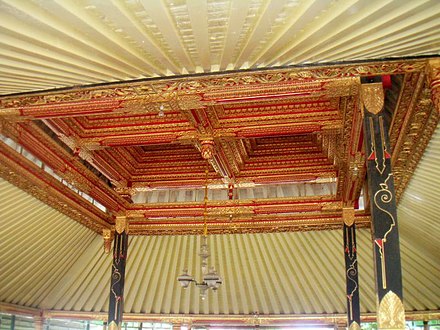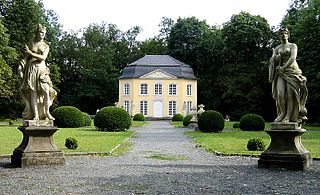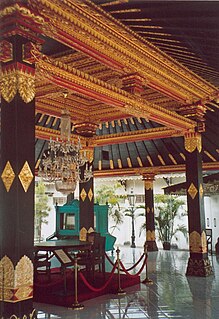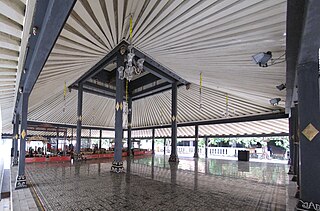

A pendopo or pendapa is a fundamental element of Javanese architecture; a large pavilion-like structure built on columns. Either square or rectangular in plan, it is open on all sides and provides shelter from the sun and rain, but allows breeze and indirect light. The word pendopo is cognate to the Sanskrit word mandapa ("hall").[ citation needed ]

Java is an island of Indonesia, bordered by the Indian Ocean on the south and the Java Sea on the north. With a population of over 141 million or 145 million, Java is the home to 56.7 percent of the Indonesian population and is the world's most populous island. The Indonesian capital city, Jakarta, is located on its northwestern coast. Much of Indonesian history took place on Java. It was the centre of powerful Hindu-Buddhist empires, the Islamic sultanates, and the core of the colonial Dutch East Indies. Java was also the center of the Indonesian struggle for independence during the 1930s and 1940s. Java dominates Indonesia politically, economically and culturally. Four of Indonesia's eight UNESCO world heritage sites are located in Java: Ujung Kulon National Park, Borobudur Temple, Prambanan Temple, and Sangiran Early Man Site.

Architecture is both the process and the product of planning, designing, and constructing buildings or any other structures. Architectural works, in the material form of buildings, are often perceived as cultural symbols and as works of art. Historical civilizations are often identified with their surviving architectural achievements.

In architecture, a pavilion has several meanings. In architectural terminology it refers to a subsidiary building that is either positioned separately or as an attachment to a main building. Often its function makes it an object of pleasure.
Contents
The Dutch writer Multatuli in his colonial reformist novel Max Havelaar described the pendopo thus: "After a broad-brimmed hat, an umbrella, or a hollow tree, a 'pendoppo' [sic] is certainly the most simple representation of the idea 'roof'." [1]
Dutch people or the Dutch are a Germanic ethnic group native to the Netherlands. They share a common culture and speak the Dutch language. Dutch people and their descendants are found in migrant communities worldwide, notably in Aruba, Suriname, Guyana, Curaçao, Argentina, Brazil, Canada, Australia, South Africa, New Zealand, and the United States. The Low Countries were situated around the border of France and the Holy Roman Empire, forming a part of their respective peripheries, and the various territories of which they consisted had become virtually autonomous by the 13th century. Under the Habsburgs, the Netherlands were organised into a single administrative unit, and in the 16th and 17th centuries the Northern Netherlands gained independence from Spain as the Dutch Republic. The high degree of urbanization characteristic of Dutch society was attained at a relatively early date. During the Republic the first series of large-scale Dutch migrations outside of Europe took place.

Eduard Douwes Dekker, better known by his pen name Multatuli, was a Dutch writer best known for his satirical novel Max Havelaar (1860), which denounced the abuses of colonialism in the Dutch East Indies. He is considered one of the Netherlands' greatest authors.

The Dutch East Indies was a Dutch colony consisting of what is now Indonesia. It was formed from the nationalised colonies of the Dutch East India Company, which came under the administration of the Dutch government in 1800.
Derived from ancient Javanese architectural elements, pendopo are common ritual spaces primarily intended for ceremony, and also for a variety of purposes such as receiving guests in the compounds of wealthy Javanese, and even as cottage industry work spaces. Pendopo can be constructed as a stand-alone structure or, attached to a walled inner structure (dalem), may form the front part of a traditional Javanese house (omah).

Javanese traditional house refers to the traditional vernacular houses of Javanese people in the island of Java, Indonesia. The architecture of a Javanese house is characterized by its dominant hierarchical rule reflected in the form of its roof and the organization of its layout. Javanese traditional houses may have very similar layout, but the shape of the roof determined the social and economic status of the house owners.

















